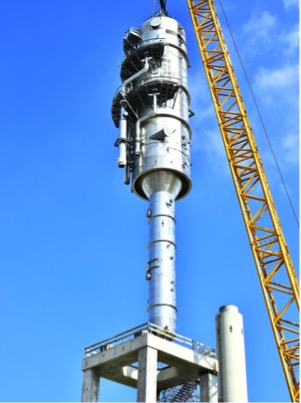Base stocks
ExxonMobil on base stock trends
12 December 2023
Please note this article was published in October 2017 and the facts and opinions expressed may no longer be valid.
11 October 2017
New workhorse for the global base stock industry

Ted Walko, Global Basestocks and Specialties Marketing Manager at ExxonMobil, talks about global trends in the base stock market and the drivers behind the company’s investment in additional Group II capacity.
Advanced engine lubricants are one of the tools OEMs rely on to help meet ever-tightening emissions legislation. The need for formulations to deliver exceptional engine protection at lower viscosity grades is driving the demand for higher performance base stocks. And, although this quality shift is being seen on a global scale, the penetration of Group II in Europe has been relatively slow.
Walko says the lack of local Group II supply in Europe means base stock needs here are largely being met by Group I and Group III base stocks. However, base stock quality demands in Europe are changing due to OEM advancements, car population turnover and an overall change in consumer buying patterns.
By 2030, ExxonMobil projects that 50% of Europe’s overall base stock demand will be for Group II products.Source: ExxonMobil assessment of publicly available information
To help meet growing demand, ExxonMobil is investing in Group II capacity additions at its Rotterdam, Netherlands, refinery. Through the expansion project, ExxonMobil’s new hydrocracker will convert heavier feed stocks into higher quality end products, such as EHCTM Group II base stocks and ultra-low sulphur diesel fuel.
 Earlier this year, ExxonMobil installed the three reactors (pictured above) which, in tandem
Earlier this year, ExxonMobil installed the three reactors (pictured above) which, in tandem “Our Rotterdam hydrocracker expansion project is on track and on time,” says Walko. “Through this project, ExxonMobil will produce industry leading EHCTM Group II base stocks in Europe for the first time. Startup is planned for Q4 2018, with commercialisation of the products in early 2019.”
 Vacuum fractionation tower at Rotterdam
Vacuum fractionation tower at RotterdamThe investment in expanding Group II capacity at the Rotterdam refinery is clearly good news for European customers.
Walko says, “Producing Group II in Europe means that global marketers with local blending operations will no longer need to recertify their products in each region or develop regional specific formulations. This not only reduces complexity but also saves them time and money.”
In addition to the investment at Rotterdam, growing demand for higher quality base stock products in Asia Pacific has prompted ExxonMobil to invest in an EHCTM Group II expansion project at its Singapore refinery.
Announced in February 2017, ExxonMobil is expanding to strengthen global supply of these products and enhance the Singapore facility’s competitiveness in the region. Construction has kicked off and completion is anticipated in 2019.
With these Group II capacity additions on the horizon, Insight was keen to learn how the new products fit into the future base stock product portfolio and whether they spell the phasing down of Group I production.
“ExxonMobil has a balanced portfolio of assets to produce Group I and Group II base stocks – a testament to our commitment to bringing the most efficient production capacity to the marketplace,” says Walko. “We are confident that ExxonMobil will be the only global producer with significant manufacturing assets strategically located in three continents, that are committed to producing Group I and Group II base stocks.”
Certain applications, such as industrial, heavy-duty diesel and marine lubricants, value Group I’s high viscosity and solvency. As such, ExxonMobil says it is committed to providing customers with a reliable supply of Group I.
Although ExxonMobil anticipates a decline in demand for Group I base stocks, they will continue to be relevant and favoured for specific formulations well into 2030.
“Our robust product portfolio includes CORETM Group I base stocks, which deliver consistent quality and broad blending coverage,” Walko confirms. “With a global network of refineries currently producing Group I base stocks, ExxonMobil has the flexibility to meet this particular customer need today and well into the future.”
As the automotive world looks for contributions to fuel economy improvements from lubricants, we wanted to understand the optimum outlet for the Group II products from a viscosity grade standpoint.
“Our high performing EHCTM Group II base stocks are used in a wide range of finished lubricant applications. They help to provide improved oxidation stability and deposit performance, superior volatility and low temperature performance capabilities versus Group I base stocks in SAE 15W-40 heavy-duty diesel engine oils and in SAE 5W- and 10W- passenger car engine oils,” Walko explains. “In addition, EHC base stocks can help to lower formulation costs since additive treat rates can be reduced and less Group III can be used in certain applications.”
Walko adds, “EHC base stocks can also provide significant efficiencies when used in combination with other base stocks, beyond the heart of the market, such as higher performance/lower viscosity automotive lubricants as well as high performance, high viscosity industrial and marine lubricants.”
ExxonMobil produces different EHCTM Group II cuts.
“In Asia Pacific we produce EHC 50 and EHC 110, in the Americas we produce EHC 45 and EHC 65 and in Europe, Africa and the Middle East EHC 50 and 120 will be produced,” says Walko. ”Lubricants blended with these base stocks can achieve equivalent performance to high quality lubricants blended with Group I/II/III due to their superior viscosity index (VI), Noack and cold flow properties.”
Walko continues, “Our base stock slate provides a range of options, which allows us to meet customers’ needs while reducing operational complexity and simplifying the tankage required for their main base stocks.”
To be successful in the base stock market it’s increasingly apparent that suppliers must have a long term commitment and the flexibility to adapt as upcoming lubricant specification changes may present challenges to overcome.
According to Walko, “Over the next few years, lubricant and base stock manufacturers will need to adjust their formulations. The most successful suppliers are those that plan ahead and maintain flexibility as the industry and customers evolve.”
ExxonMobil says long term success requires:
|
Leveraging deep value chain knowledge |
The right level of insight to help customers adapt to changing technologies and engine oil specifications. |
|
Ongoing investment |
A robust network of strategically placed refineries to ensure supply security, efficiency and cost effective product distribution. |
|
Staying at the cutting edge of technology |
Use of the best manufacturing technology and finished lubricant practices available. |
|
Putting the customer first |
Adjust and adapt to customer needs and offer reliable advice backed by deep expertise and experience. |
Walko believes that conversion technology and lubricant know-how are becoming increasingly important as the market shifts towards higher performance base stocks.
Walko concludes the interview by stating that, “By combining leading technology with leading expertise and 135 years of experience in the production of base stocks and finished lubricants, ExxonMobil can lead the industry in the development of innovative, best-in-class solutions that will continue to shape the future.”
Sign up to receive monthly updates via email